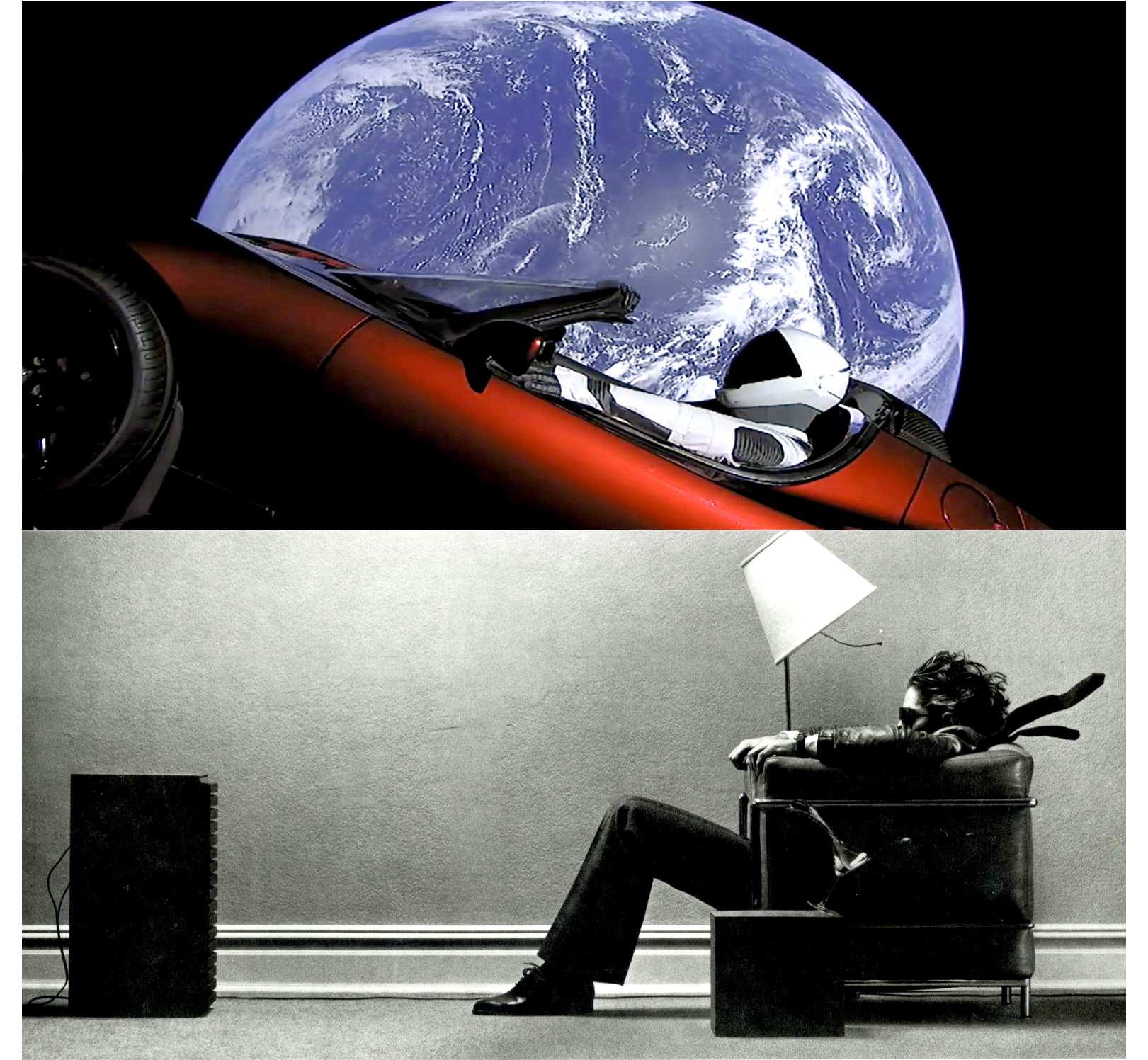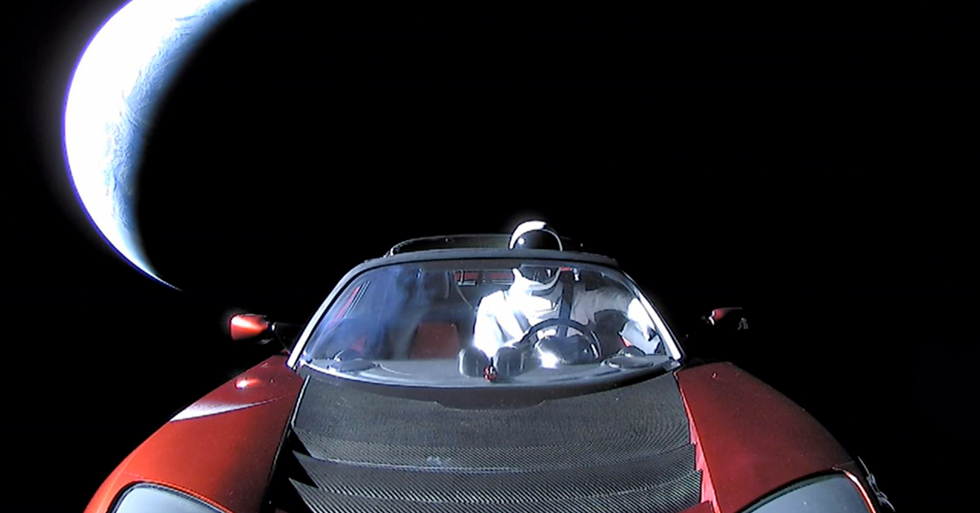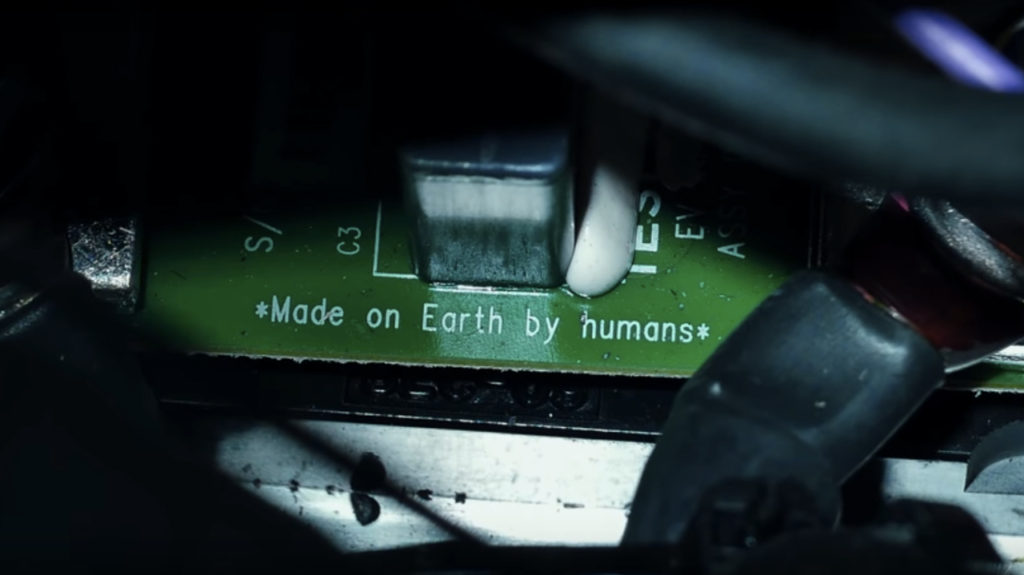A casual internet search for ‘best’ or ‘greatest’ marketing and advertising campaigns of 2018 will yield results for Weiden + Kennedy, the agency behind Nike’s famous (or infamous) Colin Kaepernick ad titled ‘Dream Crazy‘, among other notable candidates and winners; however, it appears that the greatest of them—regardless of whether it was intentionally made as such—doesn’t appear to have been in contention.
When SpaceX decided to test launch their Falcon Heavy rocket into space in February of 2018, their decision for the rocket’s payload was a playfully imaginative one: they attached into the cargo bay a Tesla roadster (owned by SpaceX CEO Elon Musk), only to have it disengage and float passively through space with cameras clung to its chassis. The cameras captured and live-steamed images of ‘Starman’ sitting in the roadster with a glorious, marbleized blue planet behind it. Surely, this is a symbol of something we can’t put into words as yet, but the image is certainly now iconic.
It’s very conceivable that this is the inadvertent winner of any and all advertising campaigns of 2018 and will rival others like that of Apple’s ‘1984’ Macintosh commercial in the canon of the ad industry—despite the fact that it wasn’t conceived within the confines of a traditional agency. Purists can save their comments as it will likely never be considered an advertising case study, but ‘Starman’ holds as an argument.
It’s difficult to quantify this event into numbers and sales, as 2018 was a tumultuous year for Musk and Tesla, but to have your brand(s) essentially plastered in orbit is somewhat priceless. Although not easily categorized, this so-called stunt served as a commercial for both Tesla and SpaceX, and ultimately what amounts to good PR for Musk. It lasted for days, and left an indelible mark on our imaginations—etching on it that clichéd line “anything is possible”.
I’m not going to pretend that I have any incite into the world of advertising or marketing in the same way others in those fields do; however, it seems the editors of advertising and marketing magazines were off the mark when compiling their end-of-year best-of lists.


IIt might be safe to say, that in decades to come—outside of a small legion of trivia fans—most will likely not remember Colin Kaepernick in the same way they’re going to remember a dummy inside a flashy, midnight-cherry-red convertible roadster “piloting” away from earth. If anything, that’s certainly the key strategy and goal to an advertising campaign—to make that kind of lasting impression—but in a few years, will people even remember the team Kaepernick played for?
By comparison, the Nike campaign feels disingenuous and contrived in its attempt at provocation, capitalizing on a moment of a hyper-politicized event in the United States. There’s something about Nike’s choice that feels almost unpalatable, specifically its timing and attempt to monetize a sensitive issue; on the one hand it’s making a political statement, but on the other, its ultimate goal is to sell sports apparel. Regardless, the campaign was a success, with Nike CEO Mark Parker boasting to Wall Street of “record engagement” with his company’s brand.
Ultimately, an ad agency’s goal is to sell product through persuasion. A trend in advertising in recent years has been narrative ad campaigns, which utilizes Fisher’s narrative paradigm to strike a chord with consumers. As opposed to an informative ad campaign (think Dyson vacuum commercials) the Nike ad takes a kind of subliminal narrative approach, attempting to manipulate with a shriek when revealing the narrator midway through the ad.
There’s something about Nike’s choice that feels almost unpalatable, specifically its timing and attempt to monetize a sensitive issue; on the one hand it’s making a political statement, but on the other, its ultimate goal is to sell sports apparel.
Where SpaceX is celebrating its own accomplishments —using the roadster as a touch of whimsy that, yes, also helps with overall brand and sales—the Kaepernick ad instead feels foisted with its sentimental artifice. We’ve heard these emotive piano chords before, coupled with images of inspiring figures (e.g. Apple’s ‘Think Different‘ ad which coincidentally starts with the line “Here’s to the Crazy ones…”). In many ways, Nike’s “Dream Crazy” ad is an iteration of the Apple commercial, using iconic figures and their accomplishments in the sports world, to convey accomplishments that they and most are unable to make themselves.
The idea of perseverance is a theme every viewer identifies with, as many see themselves within a personal narrative of struggle. Those repetitive piano chords, and the mournful vibrato of violin strings in the Nike ad play us to mush, especially combined with images of the under-privileged who’ve persevered and overcome obstacles to become remarkable.
However, when the commercial is narrated by Kaepernick, who at midpoint vocalizes the line “Believe in something, even if it means SACRIFICING EVERYTHING” as he turns to reveal himself and looks into the camera, the ad crosses over into something more akin to recondite allocution. What to that point was an incredibly inspiring ad became pedantic with one tiny gesture. In fact, the narration wasn’t at all necessary, and Kaepernick’s reveal was the sledgehammer. That said, without Kaepernick, the ad wouldn’t have been controversial and nobody would have cared, nor in the manner of engagement for which CEO Mark Parker initially hoped.
Like many narrative ad campaigns, they can often have nauseating consequences for the critical viewer; however, the goal for companies is to engage with consumers, and to increase sales, and sales is what Nike garnered.
It worked, but by comparison, Tesla sales in 2018 were also laudable, in one of the most competitive industries, topping giants BMW, Audi, Mercedes and others in the small and mid-sized luxury car sales category in July, and for all of 2018 with 138,000 vehicles sold; and its model 3 was the 11th best-selling vehicle in the U.S.
Tesla is white-hot, on-trend, and American made, selling a product—an electric vehicle—that for years has been a difficult sell for any car manufacturer, and it positively dominates the EV space both in the U.S. and worldwide. Tesla’s sales are out of this world, so it’s fitting its CEO’s roadster now too fills that domain. The time is now for the word ‘stunt’ to no longer be synonymous with ‘Musk’, and to accept any such stunt or off-kilter behaviour as free advertising.

The question then becomes: Is it SpaceX, Tesla, or simply Musk, who gets credit for this? Filming a space launch payload isn’t out of the ordinary, but attaching cameras in and around the Tesla is what deems this event as a contender for a coordinated ‘promotional strategy’ or an advertiser’s persuasive tactic—executed to its full realization.
If they haven’t already, SpaceX should be selling (or licensing) large prints of the ‘Starman’ image; and like the image of Farrah Fawcett in a red swimsuit, a shirtless Jim Morrison, or a gun-toting Al Pacino as Tony Montana, ‘Starman’ has a strong chance of becoming a poster taped to dorm-room walls with ubiquity around the world. The event has even created auxiliary products like mugs, tees and its own comic book, and if you’re curious to know where the roadster is currently, or its future trajectory, you can visit whereisroadster.com
The image of Starman nestled in the driver’s seat with its arm rested on the door conjures the famous image of Maxell’s “Blown Away” ad of the 80s, particularly with its overall cool factor. More than simply cargo for a test launch, the roadster exploit—more of an orchestrated lark—coincides with feats that were engineering firsts. Not only does The ‘Starman’ image represent humanity’s incredible ingenuity, it exhibits our collective sense of humour and our desire for more, of life’s more elusive of elixirs—inspiration.

